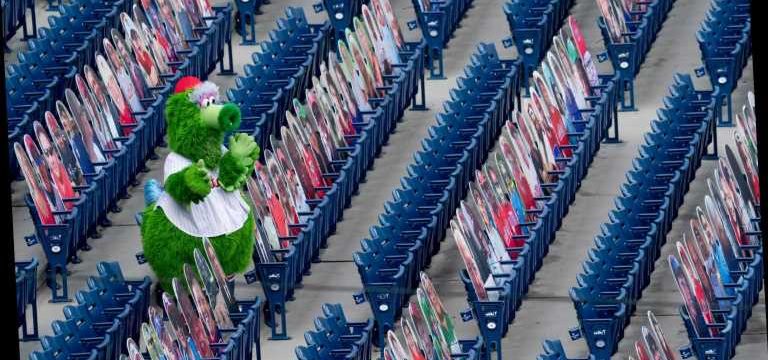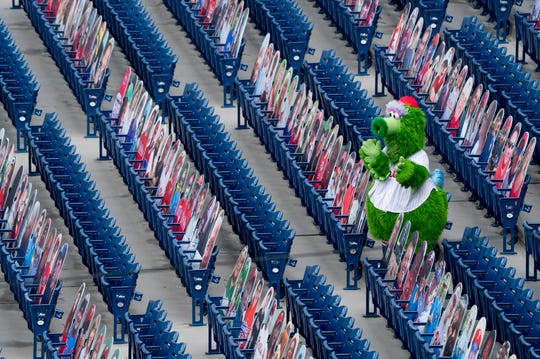If 2020 was all about cardboard cutouts, consider 2021 the year of the zip tie in sports.
They are nasty little things, hard and nylon and unyielding, and in a global pandemic, they are increasingly impossible to miss in stadiums around the world. They serve a dual purpose — cordoning off a cluster of seats, while ensuring we remain apart from one another.
From college football hotbeds to cavernous NFL stadiums to Major League Baseball’s playoffs, they’ve rendered useless thousands of seats, all in the name of separating ticket-buyers by at least six feet and, theoretically, creating a cold visual reminder that fans are not to stray out of their designated “pod” of close contacts.
And their continued presence or gradual retirement may be as good a gauge as any of “normalcy” entering a second year of playing and watching sports amid the coronavirus.
Here's hoping the Phillie Phanatic will be entertaining fans and not cardboard cutouts at some point in 2021. (Photo: Chris Szagola, AP)
If 2020 saw an abundance of caution give way to a tentative and at times uneven return to play, 2021 will be a bridge year — a bridge, hopefully, to full-time normalcy for the athletes in our arenas and the fans who hope to populate them.
As production and distribution of a COVID-19 vaccine continues apace, the games will go on, much as we experienced them in 2020:
Near-daily testing for athletes. Severely reduced capacity for fans — if any are allowed at all, based on local health regulations — and mandatory mask-wearing for those who do attend.
The ethical and moral dilemmas will continue, as well. If 2020 provoked questions of whether healthy athletes should consume hundreds of thousands of coronavirus tests while symptomatic citizens queued for hours and sometimes waited weeks for results, vaccine distribution will define the coming year.
20 FOR 2020: Sports figures who defined courageous and kind, selfish and stubborn
GOOD SPORTS: 20 sports figures who made the world a better place in 2020
OPINION: Sports will never be the same after 2020. Here's the good and bad
As the waiting list shifts from the obvious to subsequent tiers of essentiality, where do athletes fit in?
And can the vaccine be distributed swiftly enough to take a razor blade to those zip ties, congregate shoulder to shoulder in the cheap seats and try to pretend 2020 never happened?
“The quicker we vaccinate people over 70, the faster pro sports can have fans in stands,” says Will Humble, executive director of the Arizona Public Health Association. “(COVID-19) will stay as a sporadic disease. We will not have immunity until at least late summer.
“But that doesn’t mean you can’t get back to normal before that.”
Even a heavily-regulated “normal” will represent significant progress.
'Social animals'
The NBA had just 73 days from the conclusion of perhaps sport’s greatest triumph of 2020 — a “bubble” in Florida within which the regular season and playoffs were completed without a single COVID-19 case — and the start of the 2020-21 season.
Now, it has joined Major League Baseball and the NFL in contesting games at home arenas, with all the protocols that come with it. The league has already postponed one game and quarantined several players due to contact tracing.
Yet it has exceeded the bubble in one area already — fans. Six teams, taking advantage of looser local guidelines, have welcomed paying customers in a limited capacity, ranging from about 2,000 to 4,000 per game.
“When you talk to our players, when we were all down in Orlando, they desperately missed (fans),” NBA Commissioner Adam Silver said in a news conference on the eve of the Dec. 22 season opener. “I think everybody is accepting that this is the best we can do under the circumstances.”
Not all teams are embracing paying customers just yet. In Texas, where Gov. Greg Abbott flung open not just stadium doors but also the welcome mat for relocated jewel events like baseball’s World Series and the College Football Playoff semifinal, the Houston Rockets are the only one of the state’s three NBA teams to immediately host fans, at up to 25% capacity.
The Dallas Mavericks have not provided a timetable for including fans, telling season-ticket holders they will consult local health officials and the NBA to determine “the best possible scenario.” San Antonio Spurs owner R.C. Buford announced Monday the team will continue playing home games without fans, with the COVID-19 positivity rate in Bexar County reaching 19%.
“While we are confident in the plans and protocols we have in place,” said Buford, “we are uncomfortable hosting fans at this moment as the COVID-19 numbers and data in our community continue to trend in the wrong direction.”
Unlike most football and baseball games, basketball is contested indoors, where coronavirus spread can be much more prevalent. Yet Humble said he believes behavior, far more than locale, matters most.
His state of Arizona was another early-opening, sports-welcoming haven, well ahead of a summer wave of coronavirus cases and deaths. Yet Arizona on Dec. 24 set a single-day high of 4,226 hospitalizations, a surge attributed partially to unregulated youth sports tournaments in the area.
The city of Phoenix banned youth tournaments on Dec. 2, two weeks after nearly 800 youth sports teams from dozens of states converged on Maricopa County on the weekend of Nov. 20.
“We have several outbreaks that we have associated with club sports and clubs sporting events,” Marcy Flanagan, executive director of Maricopa County Public Health, said last month.
Humble said it is not the athletes, but parents who are the problem — crowding together closely on sidelines and in stands, disregarding mask requirements and rendering moot municipal mitigation guidelines.
“The vast majority of the parents are completely ignoring the masks,” said Humble, “and it showed up all autumn in the contact tracing not just in high school, but club sports. It caused tons of spread. And there’s no governing body to control.
“In Arizona, when you rent the field, you have to have a mitigation plan you file with the city and Department of Health, but there’s no enforcement. So, it’s a joke.”
Professional leagues have both money to mitigate and muscle to enforce. MLB played an entire season and most of the playoffs without fans before welcoming around 10,000 patrons to National League Championship and World Series games at Globe Life Field in Texas.
Masks were required for entry, and compliance was generally strong as fans walked the pregame concourse and cheered from their roped-off seats. But as games dragged into the night, mask use slipped.
And therein lies one of Humble’s biggest concerns for 2021: A loophole at most stadiums enabling fans to pull down their mask so long as they are eating or drinking.
Humble is warily eyeing the Phoenix Open, staged in Scottsdale over Super Bowl weekend and famous for its 16th hole bacchanal.
“If you make an exception for booze, and everyone is drinking booze, then there’s no mask,” he said. “If you distance people, require masks, and it’s dry, then you can get good adherence. But the moment you start selling beer, you throw away the mask — and good judgment."
Shot clock
Someday, perhaps, this all will be incidental.
COVID-19 vaccines authorized for emergency use by the FDA — one from Pfizer, another from Moderna — are making their way to first- and second-phase recipients, as outlined by the Centers for Disease Control and Prevention’s Advisory Committee on Immunization Practices.
There are nearly 75 million people in these groups, which include health-care personnel, long-term care facility residents, first responders and corrections officers, food and agriculture workers, the Postal Service, manufacturing, grocery stores, public transit and education, and anyone 75 or older.
Another 130 million fall in the next group: Ages 65-74, ages 16-64 with high-risk medical conditions and any previously uncovered essential workers.
So, where do athletes fall in line?
Silver said that the NBA “in no form or way will jump the line” regarding vaccinations. Immunologist Anthony Fauci recently estimated vaccines could be available to the general public by late March or April.
Sports’ place in line may initially be determined by how “essential” athletes are considered in providing entertainment and distraction.
Come February, the NBA and NHL will be nearing midseason, MLB teams will report to spring training and the NFL will stage its Super Bowl. Golf and tennis tours will be in full swing; college basketball hopes to welcome back March Madness.
MLB, NBA and NHL players would require around 2,500 vaccines to immunize its player populations (or 5,000 doses, given the two-shot regimen). There would be some additional public interest in vaccinating players given their rigorous travel schedules and close contact with the public.
“I don’t have an answer. But I don’t reject out of hand that professional athletes aren’t essential,” says Humble. “Not in terms of food on the table, but social and emotional health. Let’s face it — sports mean a lot to a lot of people.”
If 2020 taught the sports industry anything, it’s to assume virtually nothing. Supply-chain issues or, worse yet, side effects that emerge as vaccine production ramps up could reset the timeline.
“I’m going into it thinking that we are going to be in a similar situation as last year, and I think that’s a reasonable place to start,” said Minnesota Twins manager Rocco Baldelli. “We want to be optimistic, but I think that’s where our heads have to be. Starting on the (optimistic) side of it and then being shell-shocked when we have to go into our protocols in February or March — maybe it’s all psychology."
The vaccine’s 2021 delivery to the general public may coincide with the exact point on the calendar when the coronavirus shut down all sports last March. That means baseball will be aiming to launch a season as the NBA and NHL look toward their playoffs.
And once again looming in the autumn distance: Football, where the financial and cultural stakes are the highest. The NFL is on the verge of a significant triumph, completing a season in its entirety, despite football's high-contact nature and the virus spiking around it.
Next year, there may be more than a smattering of fans to watch them.
But reaching herd immunity to accommodate capacity crowds may prove elusive. Fauci recently estimated that 85% of the population would need to get vaccinated to achieve immunity; a recent Associated Press poll indicated 25% of Americans won't accept the vaccine when offered.
And though the more than 2 million Americans who have received the vaccine seems like a large number, the overall rollout is already missing expectations. Health and Human Services secretary Alex Azar on Dec. 9 estimated 20 million Americans would receive the vaccine by year's end.
With so many remaining variables, 2021 will be unpredictable. If nothing else, the sports industry is prepared for the worst, hopefully having weathered it already.
And perhaps we’ll eradicate the zip ties, in favor of those that bind us.
“I am optimistic,” said Baldelli, “that at some point, and hopefully it’s next year, we can relax in some ways. Because living in some kind of fear that you’re going to get this virus takes away from your quality of life. I think we’re getting to the point where we can look out there and see that light we’re all hoping is going to arrive soon.
“Again, we don’t know when it’s going to be. But we can start to see it.”
Contributing: Jeff Zillgitt
Source: Read Full Article

